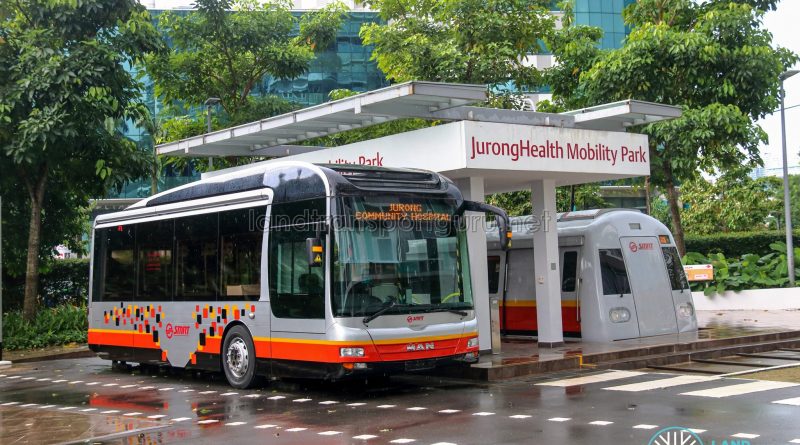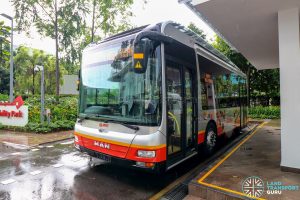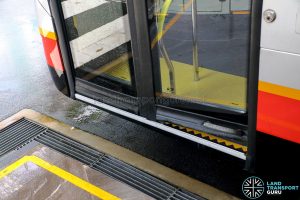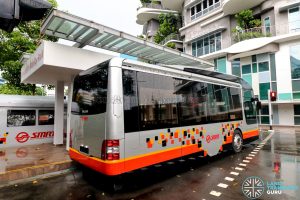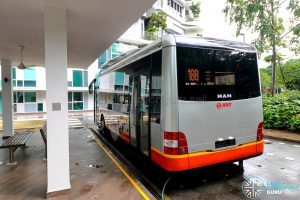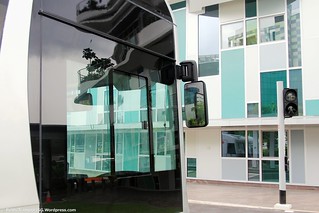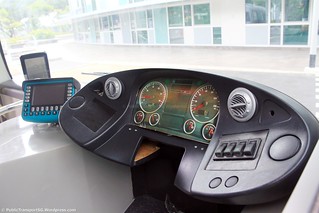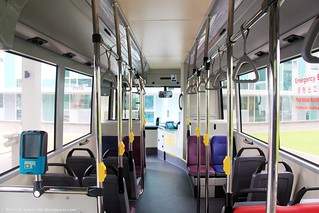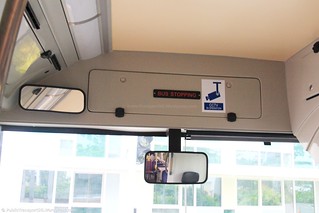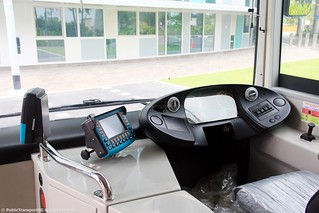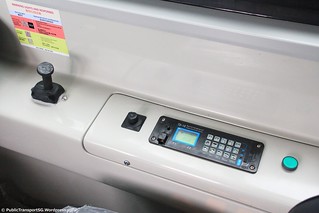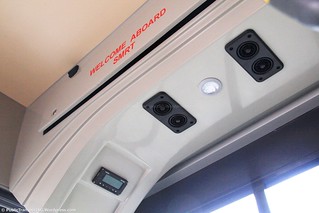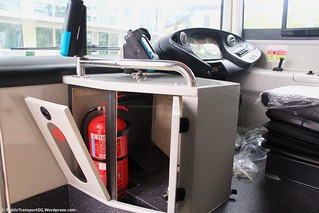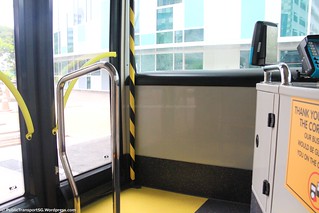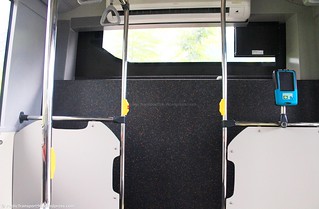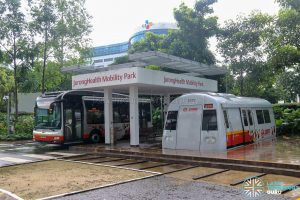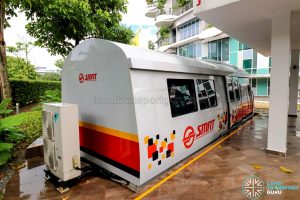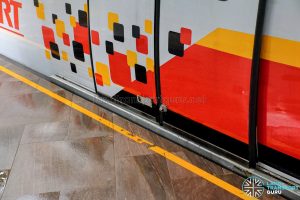Situated in an open garden within the integrated healthcare hub comprising Ng Teng Fong General Hospital (NTFGH) and Jurong Community Hospital (JCH), the JurongHealth Mobility Park is purpose-built next to the JCH’s indoor rehabilitative facility as part of its holistic care.
For transport enthusiasts, the centrepiece of the park is two mock-ups, that of a low-floor MAN A22 bus and a train cabin that resembles a KSF C151A. The park was officially launched on 7 January 2016 by Mayor of South West District Low Yen Ling.
The park boasts features such as simulated home and community environments for physical rehabilitation which will be used to prepare patients for their discharge and to help them regain their confidence in moving and getting around.
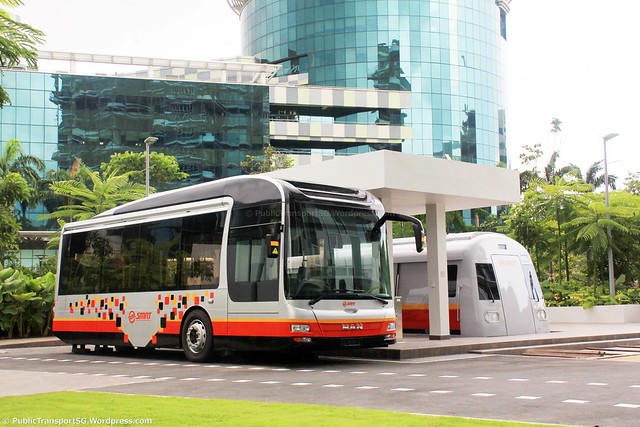
The mock-up train carriage and bus were sponsored by SMRT as part of the company’s corporate social responsibility in enabling and empowering mobility. Patients guided by hospital therapists would make use of them to simulate taking public transport as part of discharge preparation, which would help patients gain confidence and preparing them for re-integration back to the community. Along with other rehabilitative features, the park is a culmination of a 3-year partnership between JurongHealth and SMRT.
More on the JurongHealth Mobility Park
A first in Singapore, the JurongHealth Mobility Park features a life-like simulated environment with pedestrian crossings, walkways with different surface, ramps, steps as well as a decommissioned taxi, a low-floor bus mock-up and a life-sized mock-up of a part of the train cabin. Sharing the same mission of enabling and empowering mobility, the decommissioned taxi and public transport mock-ups are sponsored by SMRT Corporation Ltd (SMRT).
The JurongHealth Mobility Park mirrors familiar settings such as the bus stop or waiting bay so that the patients can regain confidence as part of discharge preparations. The hospital’s therapists will guide patients to expand their range of mobility and learn the use of public transportation and road safety with assistive aids such as walking frames, crutches or wheelchairs. Caregivers play a very important role in the post-discharge care of the patients so such training will serve to provide the necessary skills as well as empower them with the confidence and know-how.
The SMRT bus (under 2 tonnes) and train cabin (4.5 tonnes) were delivered in early November 2015 and hoisted into position by crane. These life-sized mock-ups are specially commissioned and bring to fruition the 3-year partnership between JurongHealth and SMRT as part of SMRT’s corporate social responsibility in advancing mobility.
The Bus Mock-up
The bus mock-up features a fully-furnished MAN A22 low-floor bus from the entrance to the exit door. Operated by SMRT Buses in large numbers, the MAN A22 shares many characteristics with other low-floor and low-entry buses in Singapore, most relevant being the zero-step entry and exit, and the wheelchair accommodating features built around the rear door. The mock-up was built by Gemilang Coachworks, the bodywork assembler of the MAN A22.
At first glance, the exterior mock-up bears many similarities to a regular MAN A22, featuring the roof “hair” design, identical body panels on the front and rear, rear view mirrors, and doors systems by Masats. However, a closer look reveals that the mock-up is not built on a chassis – it is simply propped above the ground – and the tyres are simply mounted for aesthetics. Furthermore, the tyres don’t have rimcaps mounted on them.
The model is also stickered with a modified version of SMRT’s new pixel livery. The pixel patterns are compressed to fit within the length of the bus, hence resulting in the smaller-than-usual patterns and company logo. Despite the down-scaling of the bus, the roof “hair” design is identical to those used on the life-sized bus, and hence stretches across nearly the full length of the mock-up. The use of original MAN A22 body panels adds overall realism to the mock-up.
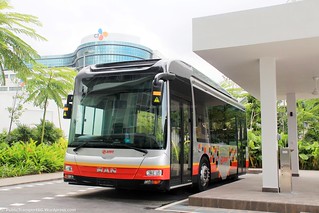 Front kerbside |
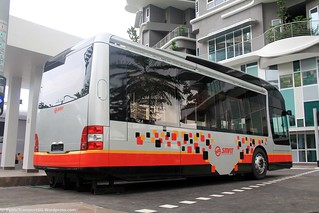 Rear offside |
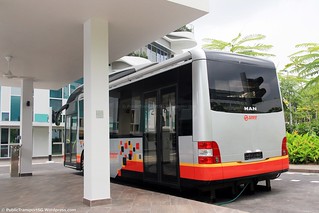 Rear kerbside |
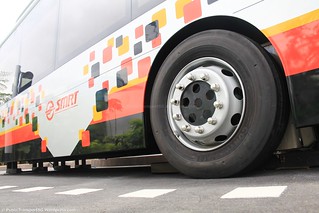 Underneath |
Inside, the bus appears to feature all the interior furnishings of a regular MAN A22, up till the rear door. Doors systems supplied by Masats are installed, consisting of a pneumatic double-leaf entrance door and an electric sliding plug exit door (but they probably aren’t powered, owing to the lack of activating buttons). Wheelchair accessibility features are identical, such as the manual wheelchair ramp and wheelchair bay with a folding seat. The drivers console is solely for display – simply a plastic mould without working buttons. The steering wheel has also been removed, and the central display window has been stickered over with images of where actual dials would be. The handbrake also appears to be an immovable piece of moulded plastic.
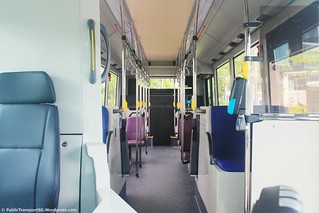 Interior |
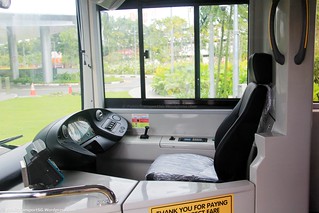 Driver’s cabin |
The mock-up is also furnished with electronic components which enhances its realism. We observe that the interior contains a bell system (both normal and wheelchair stopping bells) and a Bus Stopping indicator at the front. Additionally, an Integrated Driver Fare Console (IDFC) and two pairs of card readers at the entry and exit doors have been installed. Two Mobitec Electronic Display Signages (EDS) of the Orange LED model have been installed on the front and side, with a controller unit mounted above the driver’s cab. A TD-10 station announcer system controller is also installed at the side of the driver’s cab. Whether or not functioning Bus Stopping bells, card readers, LED display signages, and interior announcements will be featured when the model is up and running, still remains to be seen.
The Train Mock-up
Construction of the train car mock-up was performed by LexBuild in 2015.
External Links & References:
- JurongHealth Mobility Park – Singapore’s first outdoor rehabilitative space with life-sized replicas of public transportation and simulated streetscape – JurongHealth
- Singapore’s first Mobility Park for rehabilitative care in Jurong Community Hospital – JurongHealth
- Mobility park to help rehabilitate patients opens at Jurong Community Hospital – CNA
- Simulated park steps up patient recovery – The Straits Times
- SMRT Facebook Post
- JurongHealth Facebook Post
- Design and Build Life Size Mock Up Train Car for Ng Teng Fong Hospital Mobility Park – LexBuild [Accessed 20 Jun 2020]
Back to Bus Interchanges and Terminals
Back to Bus Articles
